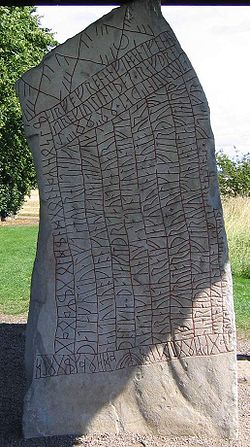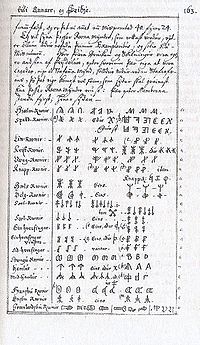
Cipher runes
Encyclopedia

Cryptography
Cryptography is the practice and study of techniques for secure communication in the presence of third parties...
replacement of the letters of the runic alphabet
Runic alphabet
The runic alphabets are a set of related alphabets using letters known as runes to write various Germanic languages before the adoption of the Latin alphabet and for specialized purposes thereafter...
.
Preservation
The knowledge of cipher runes was best preserved in IcelandIceland
Iceland , described as the Republic of Iceland, is a Nordic and European island country in the North Atlantic Ocean, on the Mid-Atlantic Ridge. Iceland also refers to the main island of the country, which contains almost all the population and almost all the land area. The country has a population...
, and during the 17th and the 18th centuries, Icelandic scholars produced several treatises on the subject. The most notable of these is the manuscript Runologia by Jón Ólafsson
Jón Ólafsson
Jón Ólafsson is the name of:*Jón Ólafsson from Grunnavík*Jón Ólafsson...
(1705-1779), which he wrote in Copenhagen
Copenhagen
Copenhagen is the capital and largest city of Denmark, with an urban population of 1,199,224 and a metropolitan population of 1,930,260 . With the completion of the transnational Øresund Bridge in 2000, Copenhagen has become the centre of the increasingly integrating Øresund Region...
(1732-1752). It thoroughly treats numerous cipher runes and runic ciphers, and it is nowadays preserved in the Arnamagnæan Collection
Arnamagnæan Collection
The Arnamagnæan Institute is a teaching and research institute established in 1956 to further the study of the manuscripts in the Arnamagnæan Manuscript Collection, the collection bequeathed by the Icelandic scholar and antiquarian Árni Magnússon to the University of Copenhagen in 1730.On July 1,...
in Copenhagen.
Jón Ólafsson's treatise presents the Younger Futhark
Younger Futhark
The Younger Futhark, also called Scandinavian runes, is a runic alphabet, a reduced form of the Elder Futhark, consisting of only 16 characters, in use from ca. 800 CE...
in the Viking Age order which means that the m-rune precedes the l-rune
Laguz
*Laguz or *Laukaz is the reconstructed Proto-Germanic name of the l-rune , *laguz meaning "water" or "lake" and *laukaz meaning "leek". In the Anglo-Saxon rune poem, it is called lagu "ocean". In the Younger Futhark, the rune is called lögr "waterfall" in Icelandic and logr "water" in Norse.The...
. This small detail was of paramount importance for the interpretation of Viking Age cipher runes because in the 13th century the two runes had changed places through the influence of the Latin alphabet
Latin alphabet
The Latin alphabet, also called the Roman alphabet, is the most recognized alphabet used in the world today. It evolved from a western variety of the Greek alphabet called the Cumaean alphabet, which was adopted and modified by the Etruscans who ruled early Rome...
where l precedes m. Since the medieval runic calendar
Runic calendar
A Runic calendar is a perpetual calendar based on the 19 year long Metonic cycle of the Moon. Runic calendars were written on parchment or carved onto staves of wood, bone, or horn. The oldest one known, and the only one from the Middle Ages, is the Nyköping staff, believed to date from the 13th...
used the post-13th century order, the early runologists of the 17th and the 18th centuries believed that the l-m order was the original one, and the order of the runes is of vital importance for the interpretation of cipher runes.
Structure of the ciphers

Younger Futhark
The Younger Futhark, also called Scandinavian runes, is a runic alphabet, a reduced form of the Elder Futhark, consisting of only 16 characters, in use from ca. 800 CE...
, which has 16 letters, they are divided into three groups. The Icelandic tradition calls the first group (f, u, þ, ã, r and k) "Freyr's
Freyr
Freyr is one of the most important gods of Norse paganism. Freyr was highly associated with farming, weather and, as a phallic fertility god, Freyr "bestows peace and pleasure on mortals"...
ætt
Norse clans
The Scandinavian clan or ætt was a social group based on common descent or on the formal acceptance into the group at a þing.-History:...
", the second group (h, n, i, a and s) "Hagal's
Haglaz
*Haglaz or *Hagalaz is the reconstructed Proto-Germanic name of the h-rune , meaning "hail" .In the Anglo-Saxon futhorc, it is continued as haegl and in the Younger Futhark as hagall The corresponding Gothic letter is h, named hagl.The Elder Futhark letter has two variants, single-barred and...
ætt" and the third group (t, b, m, l and R) Tyr's ætt". However, in order to make the inscription even harder to decipher, Freyr's ætt and Tyr's ætt change places so that group one is group three and vice versa.There are numerous forms of cipher runes, but they are all based on the principle of giving the number of the ætt and the number of the rune within the ætt.
The tent runes are based on strokes added to the four arms of an X shape: Each X represents two runes and is read clockwise, the strokes on the first arm representing the aett (row of eight runes), the strokes on the second arm the number within that aett.
The branch runes are similar, the strokes being attached to a vertical stem and branching upwards. Strokes on the left indicate the aett, and strokes on the right the number within the aett.
There are variants of these two schemes, such as inverting the numbers (counting backwards the aetts, and the runes within the aetts). Tree runes and hook runes are like branch runes, with the strokes pointing downward diagonally and curving downward, respectively.
There are several runestones using such devices of obscuring the inscription, especially found on Orkney.
A comparable system of letter modification is that of the Ogham
Ogham
Ogham is an Early Medieval alphabet used primarily to write the Old Irish language, and occasionally the Brythonic language. Ogham is sometimes called the "Celtic Tree Alphabet", based on a High Medieval Bríatharogam tradition ascribing names of trees to the individual letters.There are roughly...
"scales" recorded in the Ogam Tract.

